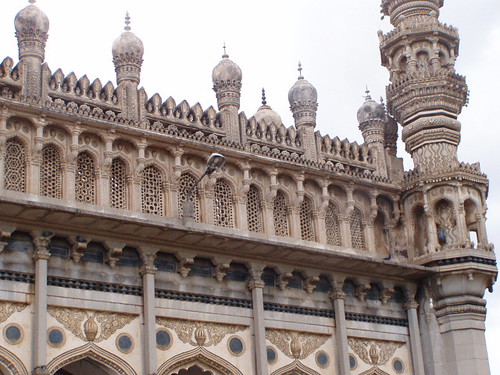 |
| Al-Aqsa Mosque No 20 |
 |
| Masjid e Tooba No 19 |
 |
| Al Fateh Mosque No 18 |
 |
| Sultan Ahmed Mosque No17 |
 |
| Grozny Central Dome Mosque No 16 |
 |
| Baitul Futuh No 15 |
 |
| Masjid-e-Aqsa no 14 |
 |
| Masjid Negara No 13 |
 |
| Id Kah Mosque No 12 |
 |
| Sultan Qaboos Grand Mosque No11 |
Khilji Mosque / Old Delhi / India
Moorish Mosque / Kapurtala / India
Old Mosque / Hyderabad / India
Unknown Mosque / Vizag / India
Jama Mosque / Jaipur / Rajasthan / India
Spanish Mosque / Secunderabad (Hyderabad) / India  Unknown Historic Mosque / Srinagar / India   Moth Mosque / Old Delhi / India  Taj-ul-Mosques / Bhopal / India    |






Toli Masjid of Hyderabad - India
The Magnificient Toli Masjid of Hyderābād India, around 300 years old
Perhaps the best specimen of Qutub Shahi Indo-Islamic architecture
Had to climb atop a heap of mud and rubble to take this shot, this side of the monument is hidden from the main entrance and is only visible if one goes around through an alley which turns around the mosque into a playground.

A wonderful example of Indo islamicand Qutubshahi architecture - Toli MasjidHyderabad India







Mecca Train Ticket Prices & Services Announced for its First Hajj Season

01 November 2010
It was announced yesterday that Muslims wishing to use Mecca's first metro when they converge on the holy city next month for their annual pilgrimage will have to pay SR250 for a ticket that will serve them for seven days.
Three different types of tickets will cover all holy sites in Mecca and will allow the pilgrims to take the train into the city to perform their rites before returning to their residence inside or outside the city, Ajel online newspaper said, quoting Habib Zain Alabidin, Undersecretary at the Saudi Ministry of Municipal affairs.
"The ticket's price is set at SR250 (US$ 67) that will cover a full trip into and out of Mecca for seven days…another ticket is priced at SR100 (US$ 27) for four days," he said.
Officials said last week the train has a capacity to transport 170,000 passengers in its first stage and two million when the third and final phase is completed.
Saudi Arabia has allocated nearly SR6.7 billion (US$ 1.8 billion) for the metro, which begins continuous service next month for the first time in Mecca's history. Officials expect the project to largely contribute to easing road congestions caused by the accumulation of thousands of cars near Makkah.
Habib Zain Alabidin says the railway would operate throughout the year.
The project is part of a costly programme by Saudi Arabia to tackle massive traffic congestions in and around the city and facilitate access to all sacred sites in Mecca.
The train project, initiated three years ago, followed a series of incidents that have killed thousands of pilgrims in stampedes, building collapses and other accidents during the few days of the Haj season.
More than two million Muslims from Saudi Arabia, the Gulf Co-operation Council countries and other nations descend on Mecca every year to perform the pilgrimage.
China Railway Construction Corp, part of a Saudi-French-Chinese consortium which won the contract, is carrying out the project, involving nearly 5,000 workers. The train is the Gulf’s second metro system after the Dubai Metro.
Sources:
"Madinah Makkah Hajj Train" Islam Newsroom October 18, 2010
WaAAada Allahu almu/mineena waalmu/minatijannatin tajree min tahtiha al-anharukhalideena feeha wamasakina tayyibatanfee jannati AAadnin waridwanun mina Allahiakbaru thalika huwa alfawzu alAAatheemu |
|
ENGLISH Translation – Dr. Muhammad Taqi-ud-Din Al-Hilali, Ph.D. & Dr. Muhammad Muhsin Khan |
[9:72] Allah has promised to the believers -men and women, - Gardens under which rivers flow to dwell therein forever, and beautiful mansions in Gardens of 'Adn (Eden Paradise). But the greatest bliss is the Good Pleasure of Allah. That is the supreme success.
|
ENGLISH TAFSIR - TAFSIR IBN ABBAS |
|
|